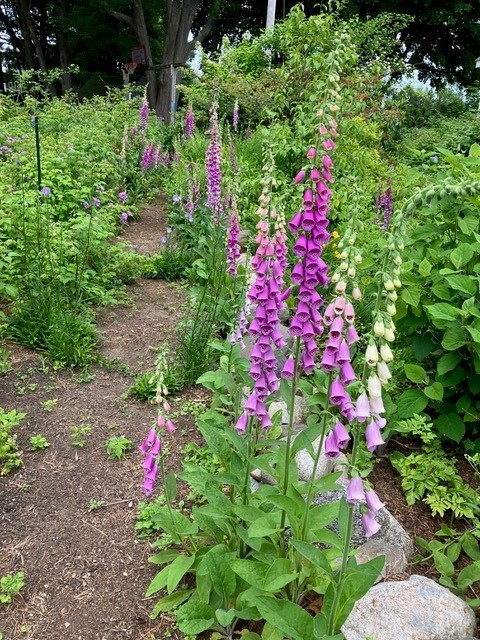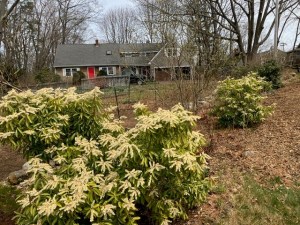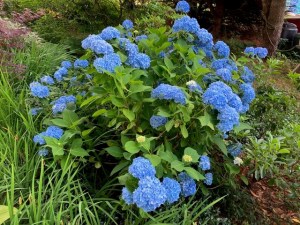
Like many of the plants in Atwell Gardens this year, the foxgloves are thriving. Photo by Tom Atwell
This year the garden is lush and green, growing fast and fast, and as I get older it's getting harder to keep up as the plants grow slower and weaker.
This year, there was barely any winter, so on our snow-free property, crocuses and irises began blooming as early as March 8th, during what was once considered the best time of the ski season, even though it was still technically winter. A snowstorm in early April melted quickly and didn't affect production one bit.
Last year's cold, wet weather limited our vegetable harvest and diminished the beauty of our flowers, so we were hopeful for an active and productive gardening season this year, and fortunately, both flowers and vegetables are thriving so far.
Encouraged by the early bloom, I planted lettuce in the cold frame on March 10. By mid-April, I was eating my home-grown lettuce in sandwiches. As an experiment, I also planted some lettuce outside the cold frame on the same day. Some of the seeds sprouted, but the leaves never grew big enough to eat. I also planted beets and carrots in the cold frame at the same time. I expect they will be edible soon.


This spring, Andromeda bushes bloomed more brightly than forsythia. Photo by Tom Atwell
Among the early-flowering shrubs, the highlight was the Andromeda (Ericaceae), along with the Rhododendron and Mountain Laurel. The Andromeda was in full bloom at the same time as the Forsythia, and I thought the Andromeda was a more vivid expression of the arrival of spring.
On April 8th, while many people were stuck in traffic trying to watch the total solar eclipse, we stayed home and watched the near-total solar eclipse at intervals through our special eclipse glasses. What else did we do that day? We planted peas 11 days earlier than the traditional Patriots Day. At the end of April, we did a second planting to spread out the harvest.
By June 22nd, we were eating our home-grown snap peas, followed a few days later by snow peas, which we hope will last until August. Along with the snap peas, we also enjoyed some freshly dug new potatoes.
The asparagus was also harvested early, so we were able to eat it before our target date of May 15. We continued harvesting for about a month.
On June 9, I harvested my first quart of strawberries. We still had strawberries left to eat by the Fourth of July, but it was late in the season. My wife, Nancy, and I were out of town for a few days in mid-June when temperatures hit 90 degrees, so many of the strawberries rotted on the vine. That was bad, but a more serious problem for strawberries is the spotted wing fruit fly, an invasive fruit fly that has infested strawberry fields in Maine and forced the pick harvest to cease in several places, including our hometown of Cape Elizabeth.
When I interviewed David Hundley, a vegetable and fruit specialist with the University of Maine Extension, in 2022, he told me that Maine's cold winters usually kill off the invasive fruit flies. In the summer, it takes several two-week generations for fruit fly populations to get large enough to damage crops, usually around August when blueberries ripen. But this year's warm temperatures seem to have caused an early and mass outbreak of spotted wing fruit flies, which is a tragedy for some farmers. I haven't seen this pest on our land yet, but I'm keeping an eye out. And if this year isn't a normal cold winter (and what is a normal cold winter anymore?), the problem could continue.
Another problem that was easily solved but would take time was removing all the oak seedlings that grew in the 2023 mast year.


The hydrangeas are doing very well this year. Photo by Tom Atwell
So far, the highlights of the season have been the flowering shrubs. The hydrangeas are stunning, continuing to bloom for several weeks and looking beautiful in all their different hues well into late autumn.
More than 20 years ago, when I started writing this column, horticulturist Michael Dill had just introduced a hydrangea called “Endless Summer.” It was supposed to bloom blue in acidic soil and pink in alkaline soil. It was also supposed to keep blooming all summer. Over time, it became a disappointment, earning the nickname “endless bummer.” But this year, it's blooming as expected.
In fact, all the flowers were gorgeous: foxgloves, irises, day lilies, peonies, clematis, poppies.
The garden was enough to keep my mind busy, which meant less time to think about arguments, politics and conventions.
Tom Atwell is a freelance writer gardening in Cape Elizabeth. He can be reached at tomatwell@me.com.
Copy story link
” previous
Why plant an American Chestnut tree that will almost certainly die?
Related article



